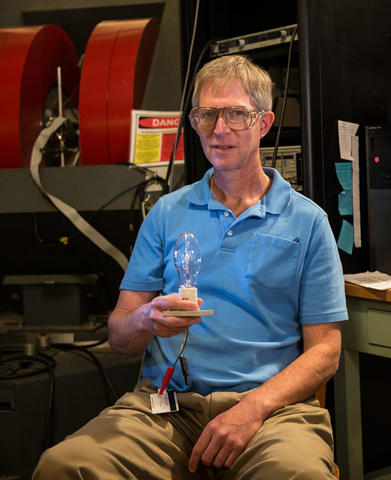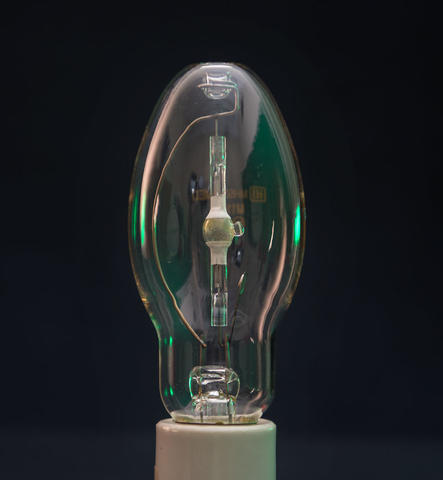
PML researcher and co-inventor John Curry with an HID lamp.
NIST has been issued a patent for a novel method to improve the performance and utility of the sort of high-intensity discharge (HID) lamps used for stadium and shopping-mall lighting, illumination for movie and TV productions that require excellent color rendition, and even indoor horticulture and automobile headlights.
Developed by John J. Curry of NIST's Physical Measurement Laboratory (PML) in collaboration with two scientists then at OSRAM Sylvania, the new scheme is intended to rectify a long-standing difficulty with metal halide* HID lamps: They can take many minutes to warm up while the halide solids in the lamp's sealed glass chamber are vaporized by an electric arc and heated to levels at which they emit white light. During that warm-up interval, they emit weak and fluctuating amounts of light in undesirable colors.
By contrast, some variations on NIST's patented system can take as little as a few seconds to reach full white-light output.
The idea got its start at a workshop in 2007, as the HID lighting industry was in the process of shifting from traditional metal halides such as sodium iodide and scandium iodide to compounds with lanthanide metals such as cerium, dysprosium, holmium, etc. "Lanthanides have very rich visible emissions," says Curry, "particularly in the red, which makes things look nice. And they are also very efficient."
A major concern, however, was how to get and keep enough of the compound in the vapor state to ensure maximum light output. For a given temperature and pressure, metal halides will only vaporize up to a certain equilibrium vapor pressure.** And there are upper limits to how much power can be fed into the arc before it damages both the electrodes and the glass vapor chamber.
"At that time, there were big questions about how various rare-earth iodides would behave," Curry says. "One of the co-inventors, Walter Lapatovich, then at OSRAM Sylvania, suggested that a particular technique I'd pioneered – x-ray induced fluorescence in lamps – could be used to answer some of those questions.
"We began a collaboration that eventually resulted in three trips to the Advanced Photon Source at Argonne National Laboratory. One of the questions we looked at was related to an exotic phenomenon called 'complexing'."
To achieve that effect, two different metal halides are mixed – the primary compound needed to generate the light, and a secondary halide that has a higher vapor pressure. The high vapor pressure of the secondary causes an increase in the amount of the primary in the vapor phase. These two different molecules form a complex, which in effect reduces the vapor pressure that the primary iodide "feels," so it keeps putting more molecules into vapor.

Curry, Lapatovich, and Edgar Estupinan (also then with OSRAM Sylvania) eventually found a number of combinations that shortened an HID lamp's warm-up time by getting more of the primary into the vapor state faster. The secondary halide indium iodide, for example, turns out to be good for raising the vapor pressures of high-performance primaries such as dysprosium iodide.
"The secondary halides are typically not great emitters of white light," Curry says, "but they can do a great job of helping the primary halide get into the vapor phase."
Regarding the effort, Curry says "It was a joint and open partnership that produced benefits for both the lighting industry and the American public. OSRAM Sylvania provided specially-prepared samples and lighting expertise, while NIST provided measurement science expertise. In addition to the patent, the effort also produced important fundamental data on lanthanide-iodides, data that is now openly available to the entire industry and other researchers."
Gerald Fraser, Chief of PML's Sensor Science Division, said of the work: "From Thomas Edison's initial invention of the modern light bulb, lighting continues to be an area of great innovation due to its importance in so many aspects of our daily lives. The present work is a clear example where a sophisticated understanding of the complex chemical and physical processes occurring within a light bulb offered the opportunity to make a significant enhancement in performance to the advantage of users who enjoy the excellent color rendering that HID lighting provides."
* Metal halides are compounds of metal atoms with halogen elements – generally iodine or bromine. In HID lamps, they exist in a solid form in a sealed glass chamber until energy from an electrical arc turns them into a vapor. The arc (the "high-intensity discharge") heats them enough to reach an atomically excited state. As they fall back to a lower-excitation state, they shed energy in the form of light. Then the molecules heat up again and the process is repeated. The result is a continuous, very bright, white light. How bright and white depends on the amount of the metal halide in the vapor state.
**Vapor pressure is the pressure generated by the vapor phase of a substance when it is in thermodynamic equilibrium with its solid or liquid phase. Substances with high vapor pressure (such as alcohol, natural gas, and anesthetic ether) are more volatile – that is, more prone to evaporate at a given temperature and pressure.

